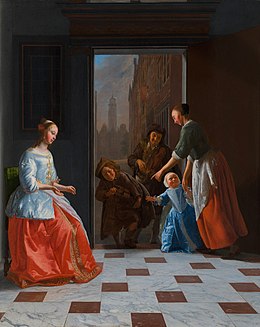
Street Musicians at the Door (Dutch: Straatmuzikanten aan de deur) is an oil painting depicting members of a wealthy family interacting with two begging musicians at the door of their house. Dutch Golden Age artist Jacob Ochtervelt (1634–1682) painted it in Rotterdam in 1665, as an example of the "entrance hall painting", a genre he pioneered. It is in the collection of the Saint Louis Art Museum.
Content and interpretation
Street Musicians at the Door depicts members of a wealthy family (a mother, child, and a maid) interacting in a friendly encounter with two musicians at the door of their house, who play a violin and a hurdy-gurdy. Ochtervelt used this setting to show the contact between the two worlds of the wealthy inhabitants within the house and the poor street people beyond. The maid and child act as intermediaries between these two worlds, with the mother showing her child how to give alms to the begging musicians. The scene reflects the morés of the time, in which beggars were expected to perform some small service (in this case, playing music) that they could be paid for. Although most critics agree that music is depicted here in a positive light, as a beneficial influence on children's minds, a dissenting view holds that the low opinion of music in Dutch Calvinism is borne out by the low position of the musicians in the painting.
Painting style
The painting style of Street Musicians at the Door uses variations in color and technique to contrast the two worlds that it depicts. The women of the house are lit brightly and dressed colorfully, and the interior is depicted carefully and precisely. The exterior streetscape leading to a church is again drawn in perspective, but appears flattened, muted, darkened, and roughly painted. The people in the painting, similarly, are shown in different styles, contrasting the dignified faces of the women with the more caricatured depiction of the musicians.
A minor detail of the interior, the Pythagorean tiling of its flooring, has been called out as an example of the long history of use of this tiling pattern.
Provenance and collection
Street Musicians at the Door was owned in the late 18th century by French art dealer Jean-Baptiste-Pierre Lebrun, and later by Dorothy L. Liggett Kilpatrick (Mrs. Claude Kilpatrick), a daughter of tobacconist and Liggett Group founder John E. Liggett. Kilpatrick bequested it to the Saint Louis Art Museum on her death in 1928, and the gift was carried out by her daughter, Mary Lois Kilpatrick Perry (Mrs. Eugene A. Perry). As of 2020 it is on display in the museum's galleries.
Related works
Similar doorway settings were frequently used by Ochtervelt, as the first examples of a genre that became known as "entrance hall painting"; Street Musicians has been called "one of the more striking examples" of this genre. The doorway, in Street Musicians and these other paintings, acts as a picture frame through which the rest of the world can be observed. Two more of Ochtervelt's entrance hall paintings also depict scenes with street musicians; others include sellers of fish and produce, similarly shown through the door of a home.
References
- ^ Street Musicians at the Door, Saint Louis Art Museum, retrieved 2020-10-07
- ^ Moore, Jerry D. (2012), The Prehistory of Home, University of California Press, p. 89, ISBN 9780520952133
- Franits, Wayne E. (2004), Dutch Seventeenth-century Genre Painting: Its Stylistic and Thematic Evolution, Yale University Press, p. 199, ISBN 9780300102376
- ^ Jacobs, Lynn F. (2017), Thresholds and Boundaries: Liminality in Netherlandish Art (1385–1530), Visual Culture in Early Modernity, Routledge, ISBN 9781351608732. See discussion following Figure 6.2, which reproduces Street Musicians at the Door.
- ^ Pokphanh, Roberta Jean (2009), The Proceeds of Prosperity: Images of Domestic Money Management and Exchange in Dutch Genre Painting in the Middle of the Seventeenth Century (Ph.D. dissertation), University of Kansas, hdl:1808/5261. See especially pp. 120–124 and 146–147.
- Dekker, Jeroen J. H. (Summer 1996), "A republic of educators: Educational messages in seventeenth-century Dutch genre painting", History of Education Quarterly, 36 (2): 155–182, doi:10.2307/369503, JSTOR 369503, S2CID 144020901
- ^ Hollander, Martha (2002), An Entrance for the Eyes: Space and Meaning in Seventeenth-Century Dutch Art, University of California Press, pp. 186–187, ISBN 9780520221352
- ^ "A memorial to Mrs. Claude Kilpatrick", Bulletin of the City Art Museum of St. Louis, 14 (1): 4, 6–9, January 1929, JSTOR 40714404
- Nelsen, Roger B. (November 2003), "Paintings, plane tilings, and proofs" (PDF), Math Horizons, 11 (2): 5–8, doi:10.1080/10724117.2003.12021741, S2CID 126000048. Reprinted in Haunsperger, Deanna; Kennedy, Stephen (2007), The Edge of the Universe: Celebrating Ten Years of Math Horizons, Spectrum Series, Mathematical Association of America, pp. 295–298, ISBN 978-0-88385-555-3.
- Spieth, Darius A. (2017), Revolutionary Paris and the Market for Netherlandish Art, Studies in the History of Collecting & Art Markets, BRILL, p. 176, ISBN 9789004276758